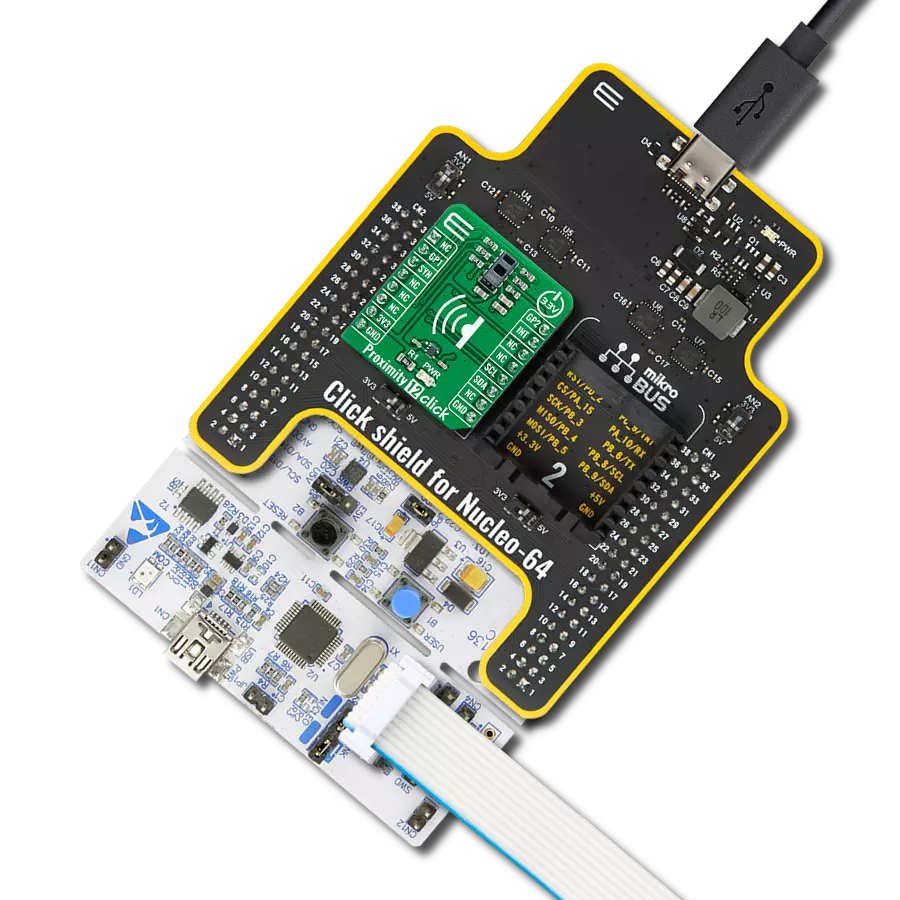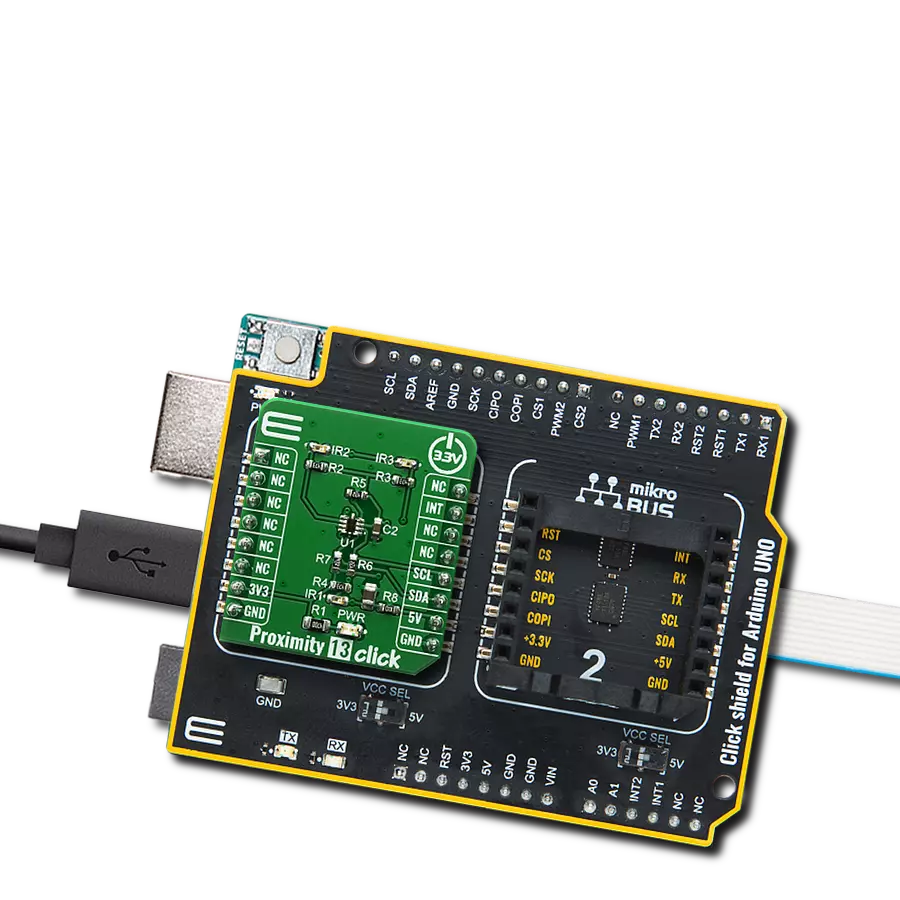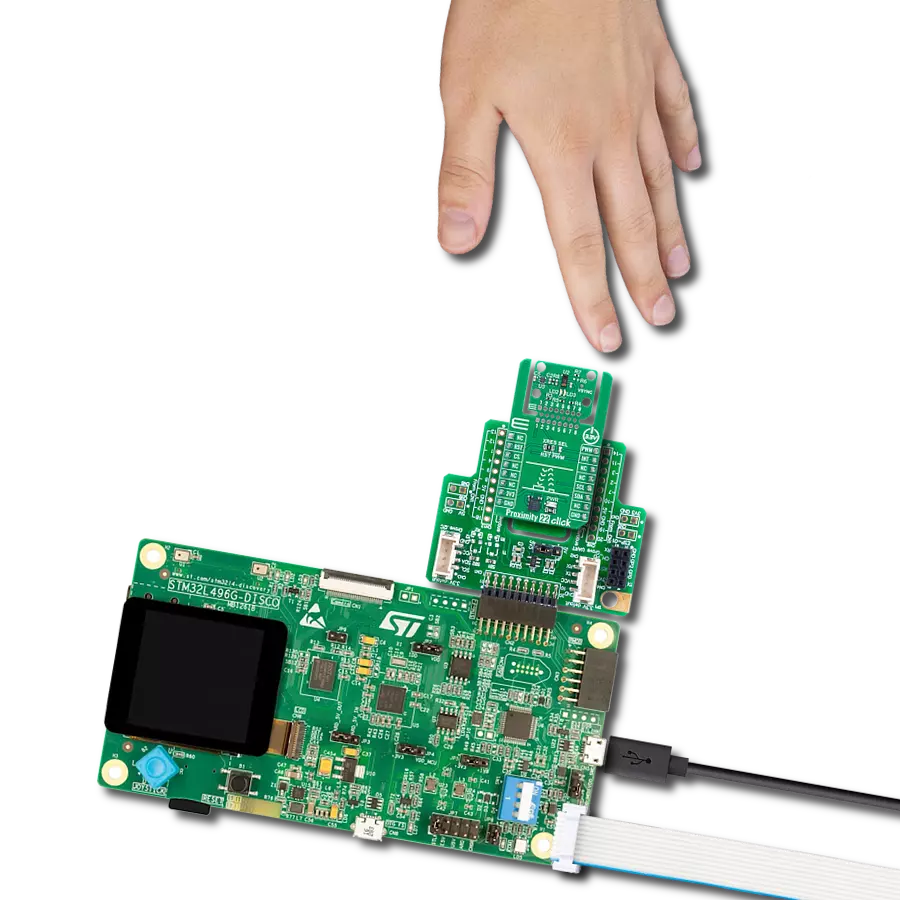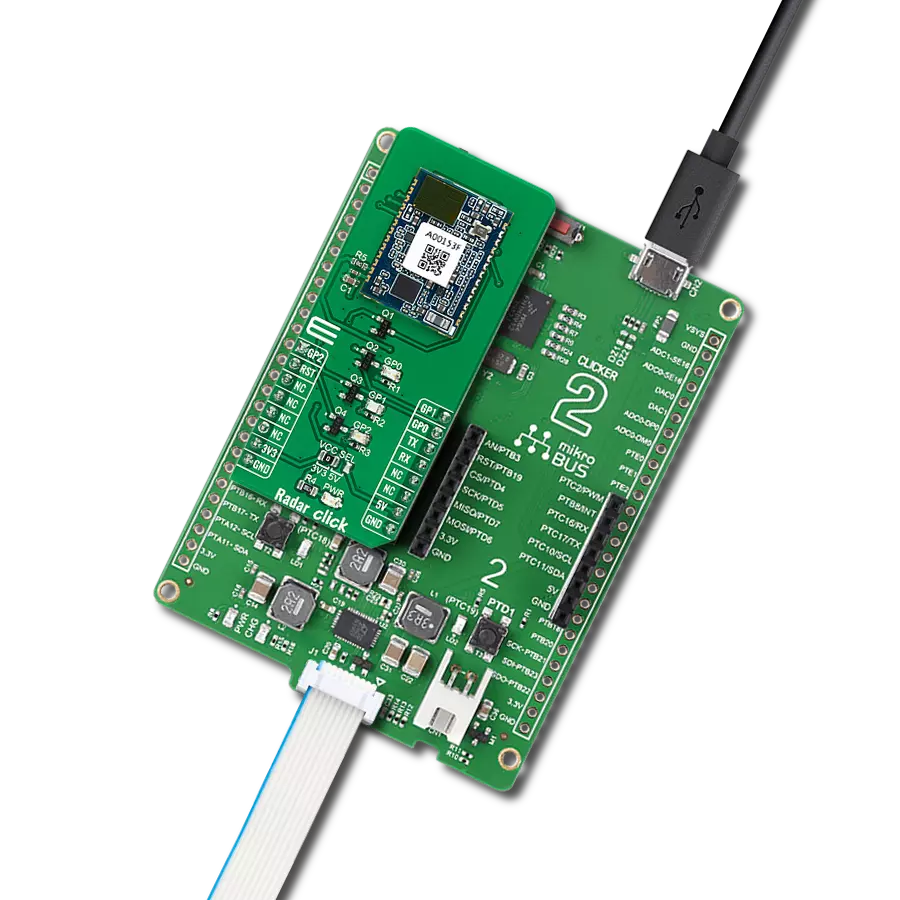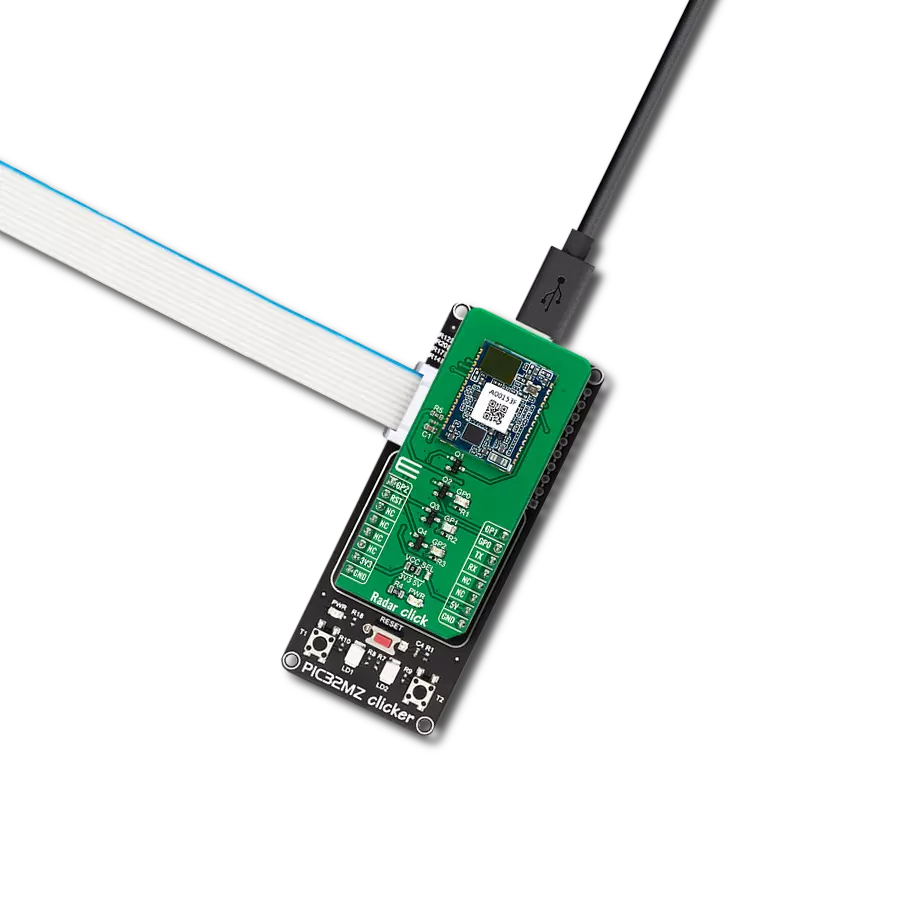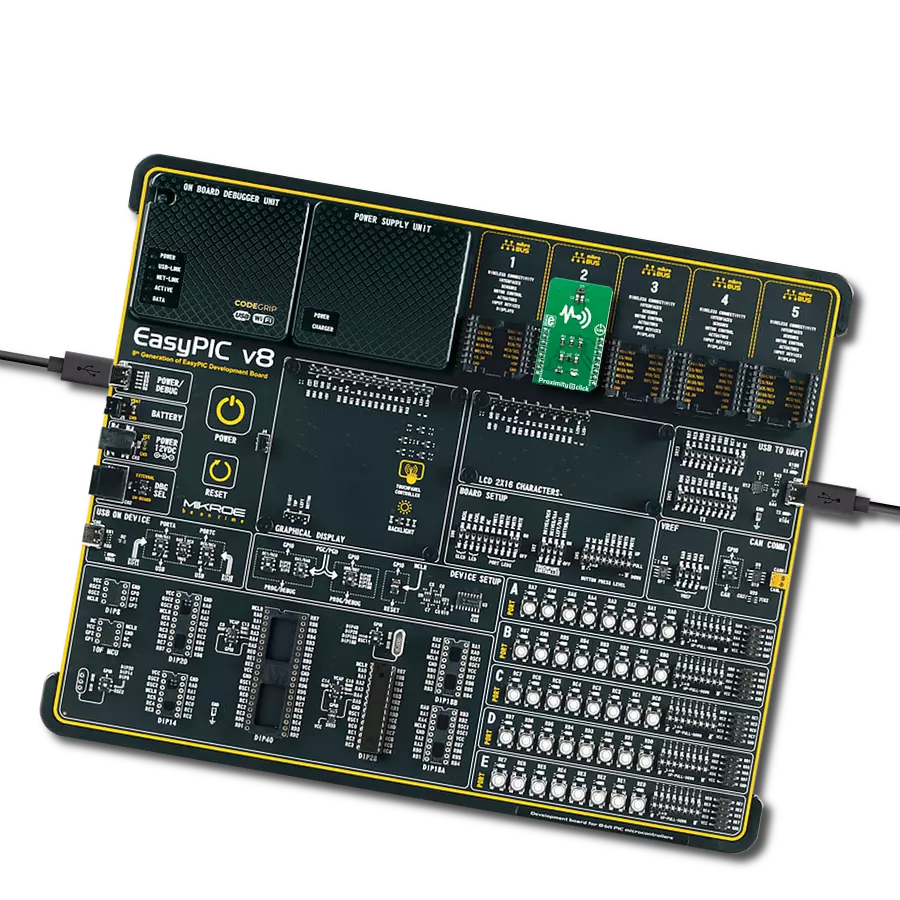Enhance safety and efficiency with real-time detection of nearby objects or individuals
A
A
Hardware Overview
How does it work?
Proximity 2 Click is based on the MAX44000, a wide-dynamic range ambient light sensor with an integrated infrared proximity sensor from Analog Devices. Designed using proprietary BiCMOS technology, the MAX44000 combines three optical sensors, two A/D converters, and digital functionality into one package. A MAX44000's photodiode array converts the light to a current, processed by low-power circuitry into a digital value which is then stored in an output register and later read by an I2C serial interface. This feature allows the MAX44000 to replicate the human eye's optical response in various environments. The infrared proximity photodiodes are optimized for better sensitivity for
near-infrared signals, specifically 850nm, and can be used for proximity sensor measurements. The proximity sensing uses an external, pulsed infrared LED source, the SFH 4651-Z, to emit controlled amounts of infrared radiation. When the SFH 4651-Z reflects some of this infrared radiation to the MAX44000, it is detected by the integrated light detector and then used to determine the object's proximity to the sensor. It is essential to note that different objects at the same distance from the sensor can reflect different amounts of infrared radiation depending on their texture and color. The MAX44000 communicates with the MCU using the standard I2C 2-Wire interface with a maximum frequency of 400kHz. This Click board™
also supports a programmable interrupt feature, routed to the INT pin on the mikroBUS™ socket, that simplifies and improves system efficiency by eliminating the need to poll a sensor for a data (ambient light or proximity receive interrupt has occurred), resulting in a significant power saving. This Click board™ can be operated only with a 3.3V logic voltage level. The board must perform appropriate logic voltage level conversion before using MCUs with different logic levels. However, the Click board™ comes equipped with a library containing functions and an example code that can be used as a reference for further development.
Features overview
Development board
Flip&Click PIC32MZ is a compact development board designed as a complete solution that brings the flexibility of add-on Click boards™ to your favorite microcontroller, making it a perfect starter kit for implementing your ideas. It comes with an onboard 32-bit PIC32MZ microcontroller, the PIC32MZ2048EFH100 from Microchip, four mikroBUS™ sockets for Click board™ connectivity, two USB connectors, LED indicators, buttons, debugger/programmer connectors, and two headers compatible with Arduino-UNO pinout. Thanks to innovative manufacturing technology,
it allows you to build gadgets with unique functionalities and features quickly. Each part of the Flip&Click PIC32MZ development kit contains the components necessary for the most efficient operation of the same board. In addition, there is the possibility of choosing the Flip&Click PIC32MZ programming method, using the chipKIT bootloader (Arduino-style development environment) or our USB HID bootloader using mikroC, mikroBasic, and mikroPascal for PIC32. This kit includes a clean and regulated power supply block through the USB Type-C (USB-C) connector. All communication
methods that mikroBUS™ itself supports are on this board, including the well-established mikroBUS™ socket, user-configurable buttons, and LED indicators. Flip&Click PIC32MZ development kit allows you to create a new application in minutes. Natively supported by Mikroe software tools, it covers many aspects of prototyping thanks to a considerable number of different Click boards™ (over a thousand boards), the number of which is growing every day.
Microcontroller Overview
MCU Card / MCU
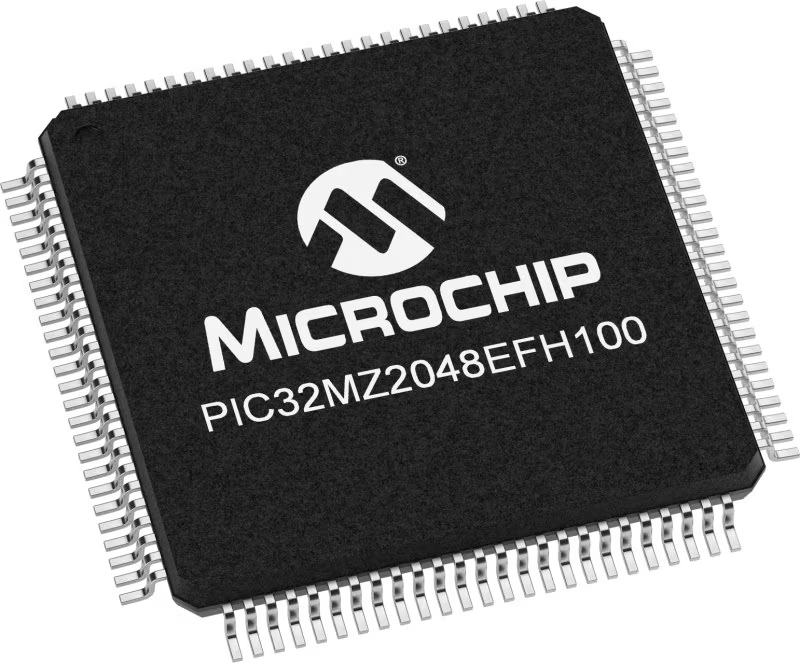
Architecture
PIC32
MCU Memory (KB)
2048
Silicon Vendor
Microchip
Pin count
100
RAM (Bytes)
524288
Used MCU Pins
mikroBUS™ mapper
Take a closer look
Click board™ Schematic

Step by step
Project assembly
Software Support
Library Description
This library contains API for Proximity 2 Click driver.
Key functions:
proximity2_read_prox- Read PROX Data Register functionproximity2_read_als- Read ALS Data Registers function
Open Source
Code example
The complete application code and a ready-to-use project are available through the NECTO Studio Package Manager for direct installation in the NECTO Studio. The application code can also be found on the MIKROE GitHub account.
/*!
* \file
* \brief Proximity2 Click example
*
* # Description
* This is an example that shows the most important
* functions that Proximity 2 Click has.
*
* The demo application is composed of two sections :
*
* ## Application Init
* Configuring Clicks and log objects.
* Setting the Click in the default configuration.
*
* ## Application Task
* Shows the most important proximity and ambient value.
*
* \author MikroE Team
*
*/
// ------------------------------------------------------------------- INCLUDES
#include "board.h"
#include "log.h"
#include "proximity2.h"
// ------------------------------------------------------------------ VARIABLES
static proximity2_t proximity2;
static log_t logger;
static uint8_t proxi_val;
static uint16_t ambient;
// ------------------------------------------------------ APPLICATION FUNCTIONS
void application_init ( void )
{
log_cfg_t log_cfg;
proximity2_cfg_t cfg;
/**
* Logger initialization.
* Default baud rate: 115200
* Default log level: LOG_LEVEL_DEBUG
* @note If USB_UART_RX and USB_UART_TX
* are defined as HAL_PIN_NC, you will
* need to define them manually for log to work.
* See @b LOG_MAP_USB_UART macro definition for detailed explanation.
*/
LOG_MAP_USB_UART( log_cfg );
log_init( &logger, &log_cfg );
log_info( &logger, "Application Init" );
// Click initialization.
proximity2_cfg_setup( &cfg );
PROXIMITY2_MAP_MIKROBUS( cfg, MIKROBUS_1 );
proximity2_init( &proximity2, &cfg );
proximity2_default_cfg ( &proximity2 );
log_info( &logger, "Application Init" );
Delay_ms ( 1000 );
}
void application_task ( void )
{
proxi_val = proximity2_read_prox ( &proximity2 );
ambient = proximity2_read_als ( &proximity2 );
log_printf( &logger, " Proximity ADC : %d \r\n", (uint16_t)proxi_val );
log_printf( &logger, " Light : %d \r\n", ambient );
log_printf( &logger, "------------------\r\n" );
Delay_ms ( 300 );
}
int main ( void )
{
/* Do not remove this line or clock might not be set correctly. */
#ifdef PREINIT_SUPPORTED
preinit();
#endif
application_init( );
for ( ; ; )
{
application_task( );
}
return 0;
}
// ------------------------------------------------------------------------ END
Additional Support
Resources
Category:Proximity


















